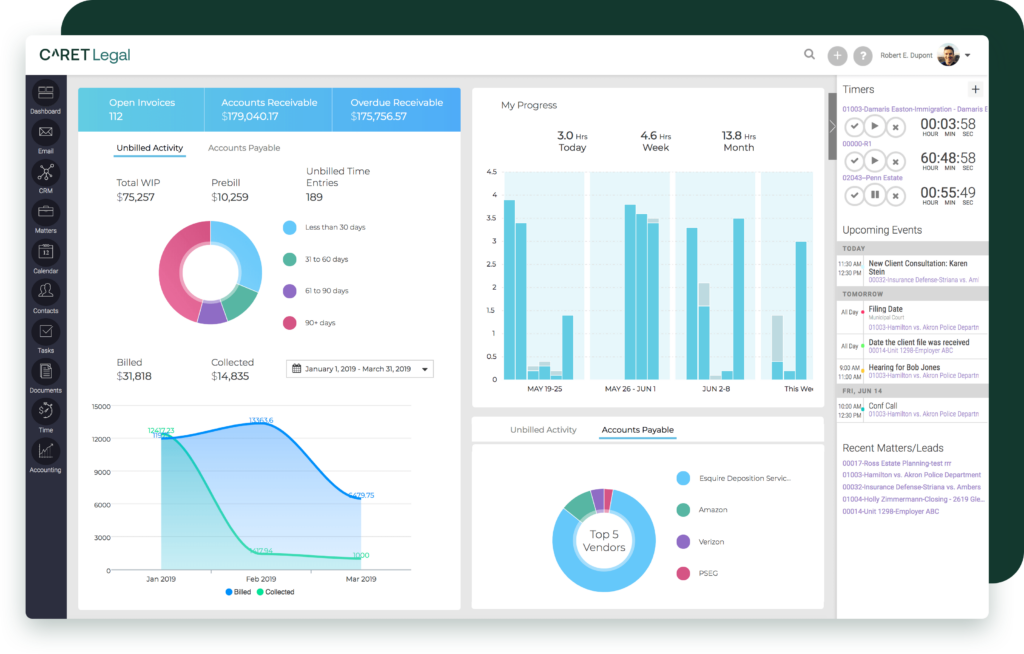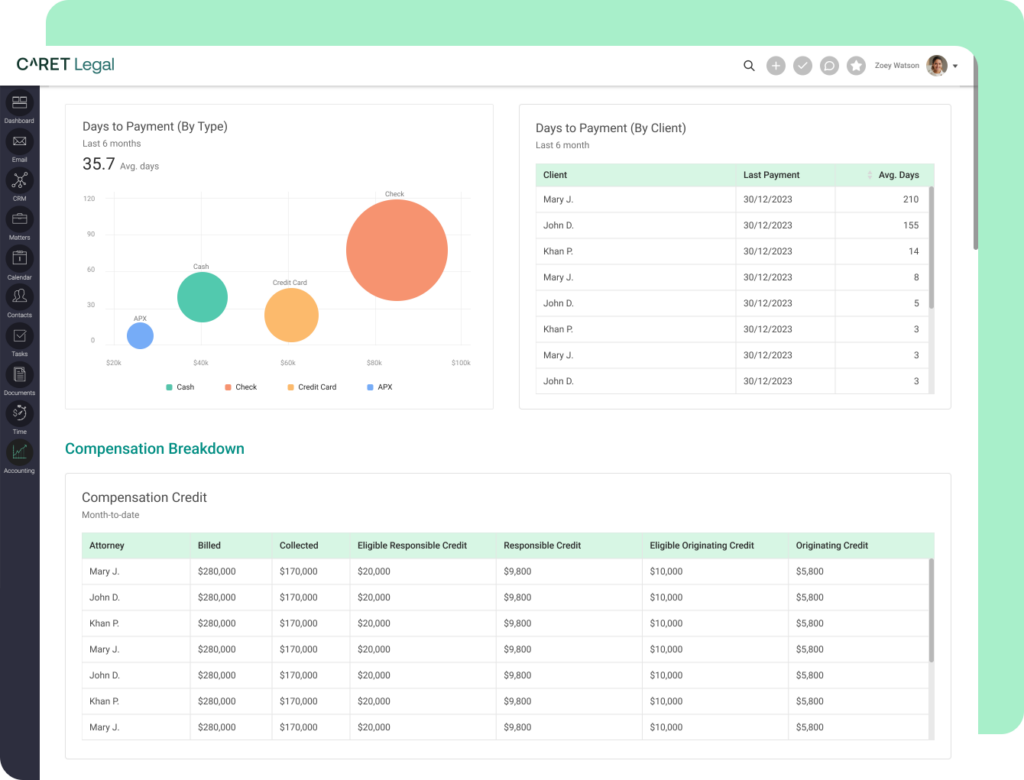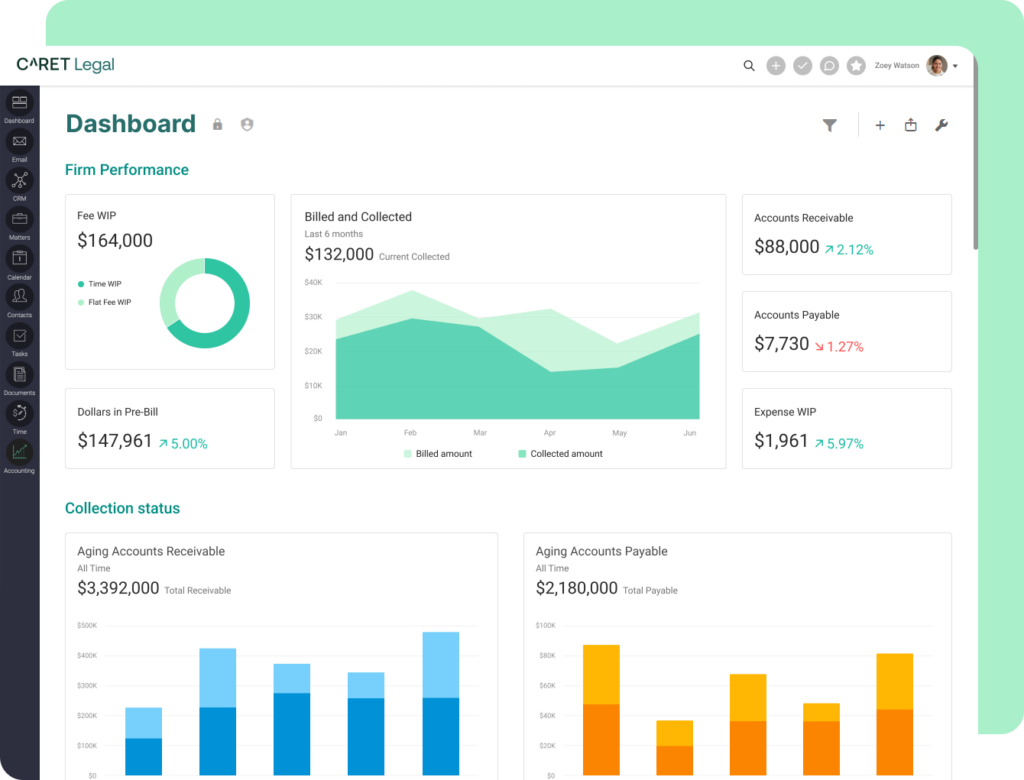Visual legal metric dashboards offer a holistic view of your firm’s performance, empowering you to stay ahead in a competitive market.
Having a centralized, visual tool for monitoring key performance indicators (KPIs) is crucial for law firms that need real-time access to critical data to make informed decisions, improve operational efficiency, and ultimately enhance client service. Visual legal metric dashboards offer a holistic view of your firm’s performance, empowering you to stay ahead in a competitive market.
The Elements of Effective Reporting
Let’s explore some of the components of effective law firm reporting.
Comprehensive Data Visualization
Effective dashboards go beyond mere data presentation; they transform raw numbers into actionable insights. They enable you to identify trends and patterns that might otherwise go unnoticed, providing a deeper understanding of your firm’s performance. By visualizing data, dashboards can highlight areas needing improvement and pinpoint opportunities for growth. This allows law firms to make proactive, data-driven decisions that enhance efficiency and drive success.

Financial Health: Visual dashboards provide a comprehensive view of your firm’s financial status. They allow you to easily track key financial indicators such as revenue streams, operating expenses, and profitability margins. By visualizing this data, you can spot trends like fluctuating cash flows or increasing costs, identify potential issues like overdue accounts receivable, and make informed decisions about where to allocate resources most effectively. Whether it’s optimizing budget allocations, adjusting billing rates, or managing debt, having these financial insights at your fingertips is crucial for maintaining financial health and ensuring sustainable growth.
Productivity and Performance Tracking: Dashboards can track metrics like work-in-progress (WIP), collections, and overall productivity. By monitoring specific productivity KPIs such as billable hours, timekeeper goals, and effective rates, you gain detailed knowledge of how efficiently your team operates. This allows you to measure the performance of individual team members and departments, identify bottlenecks or inefficiencies, and allocate resources where they are most needed. Dashboards can also highlight high-performing employees or teams, providing opportunities for recognition and replication of successful practices.
Easy Customization
Modern dashboards offer easy customization, allowing users to tailor their views without advanced technical skills. Customizable dashboards enhance individual productivity and keep the team aligned with strategic goals.
Ease of Use: Modern dashboards often feature drag-and-drop functionality, eliminating the need for complex coding. This makes it easy for users of all technical levels to create and customize their views.
Tailored Views: Different roles within a law firm have unique needs. Role-based dashboards allow associates, partners, and bookkeepers to view the data most relevant to their responsibilities. This targeted approach ensures that everyone has the information they need to perform their duties effectively.

Advanced Reporting and Alerts
Advanced reporting and alerts turn dashboards into dynamic tools. Custom reports can be scheduled to reduce manual work and errors, while real-time alerts ensure you never miss critical updates. These features provide the intelligence needed to maintain efficiency and quickly address emerging issues.
Custom Reports: The ability to create and schedule custom reports is a game-changer. For instance, you can set up weekly updates on billable hours to monitor productivity, or monthly financial summaries to track revenue and expenses. Automated reports streamline these processes, saving time and minimizing the risk of errors, ensuring you always have accurate data at your fingertips.
Alerts: Timely alerts for key metrics and upcoming deadlines ensure that nothing falls through the cracks. Alerts can be set for various triggers, such as approaching deadlines, budget overruns, or significant changes in client activity.
Metric Dashboards + Automated Reporting
The combination of visual metric dashboards and automated reporting can have a profound impact on your firm’s bottom line. When these elements are aligned, they create a powerful tool for decision-making and strategy execution.
Operational Efficiency
Automated Reporting: By reducing the time spent on manual report generation, your team can focus on more strategic tasks. Automated reporting ensures that everyone has access to up-to-date information without the need for constant manual updates. For example, automated client billing reports can streamline financial operations, while regular performance summaries keep all team members informed of their progress and areas needing attention.
Actionable Intelligence: Immediate insights enable you to make data-driven decisions quickly. Real-time dashboards can highlight performance metrics, client activities, and case statuses, allowing you to respond promptly to emerging trends and issues. This agility is invaluable in a fast-paced legal environment, ensuring your firm remains competitive and proactive.
The power of visual legal metric dashboards lies in their ability to turn complex data into clear, actionable insights.
Revenue Management
Identify Revenue Growth Opportunities: Dashboards help you spot high-value clients and practice areas by analyzing billing patterns, client feedback, and case outcomes. By focusing resources on these opportunities, you can maximize revenue and growth potential. For instance, identifying top-performing practice areas can guide strategic hiring and marketing efforts to further capitalize on these strengths.
Cash Flow Optimization: Monitoring accounts receivable and payable is essential for maintaining healthy cash flow. Dashboards provide visibility into these metrics, allowing you to implement effective collection strategies and deliver timely payments. Detailed cash flow reports can also help you identify and address any financial bottlenecks, ensuring your firm operates smoothly and efficiently.
Predictive Analytics
Future Planning: Historical data is a goldmine for forecasting future revenue and budgeting. Predictive analytics can help you plan for upcoming expenses, potential market shifts, and strategic investments. By analyzing past performance and market trends, you can make more accurate financial projections and allocate resources more effectively.
Scenario Analysis: Running “what-if” scenarios allows you to test potential strategies and outcomes. This proactive approach helps you prepare for various contingencies and make informed decisions. For example, you can simulate the impact of different billing rates, staffing changes, or marketing campaigns to determine the best course of action for your firm.
Creating Legal Dashboards Isn’t a Large Lift
Integration with Existing Systems
Seamless Data Import: Compatibility with current practice management systems is crucial for easy data integration. Solutions that offer seamless data import can prevent disruptions to your existing workflows and ensure a smooth transition. Even better, some legal practice management systems, like CARET Legal, have their own built-in analytics features. This enables you to start utilizing the power of dashboards without extensive downtime or data migration issues.
User Training and Support
Guided Navigation: Training sessions can help users navigate and utilize dashboards effectively. These sessions ensure that everyone is comfortable with the new system and can make the most of its features. By offering hands-on training, you can boost user confidence and maximize the utility of your dashboards.
Continuous Support: Ongoing support is essential for addressing user queries and customization needs. A dedicated support team can assist with troubleshooting, customization, and optimization, making the transition smoother and ensuring long-term success. Continuous support ensures that your team can fully leverage the capabilities of your dashboards and adapt to any changes or updates.
Visualize Your Firm’s Success
The power of visual legal metric dashboards lies in their ability to turn complex data into clear, actionable insights. By integrating these dashboards into your firm’s operations, you can enhance efficiency, improve client service, and drive growth.
Exploring legal metric dashboards is a step towards a more informed, strategic approach to managing your law firm. With the right data at your fingertips, the possibilities are endless.
CARET Analytics: Delivering Metrics that Matter
CARET Analytics empowers firms with predictive insights and comprehensive analytics. Using real-time data with easy-to-use visualizations, dashboards, alerts, and reports, it provides actionable business intelligence on critical metrics to keep your firm running smoothly.
With CARET Analytics, firms can gain a comprehensive view of their financial health and optimize their operations, improve resource allocation, accelerate cashflow, and make data-driven decisions with confidence.

Get Started Today
Incorporating visual legal metric dashboards into your firm’s toolkit is a strategic move that can yield significant benefits. From improved financial oversight to enhanced operational efficiency, the advantages are clear. As the legal profession continues to evolve, staying ahead of the curve with the right tools and technology is more important than ever. Embrace the power of visual dashboards and take the first step towards a more efficient, successful future for your firm.
Ready to see the benefits for yourself? Schedule a free demo with CARET Legal today and discover how our analytics feature can revolutionize your law practice.
